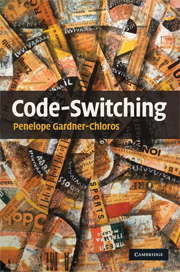Book contents
- Frontmatter
- Contents
- Acknowledgements
- Transcription conventions
- 1 Introduction
- 2 Code-switching and language contact
- 3 Social factors in code-switching
- 4 Code-switching in conversation
- 5 Grammatical aspects of code-switching
- 6 Psycholinguistic approaches
- 7 Acquiring code-switching: code-switching in children (and L2 learners)
- 8 Conclusions
- Appendix
- Bibliography
- Index
4 - Code-switching in conversation
Published online by Cambridge University Press: 10 February 2010
- Frontmatter
- Contents
- Acknowledgements
- Transcription conventions
- 1 Introduction
- 2 Code-switching and language contact
- 3 Social factors in code-switching
- 4 Code-switching in conversation
- 5 Grammatical aspects of code-switching
- 6 Psycholinguistic approaches
- 7 Acquiring code-switching: code-switching in children (and L2 learners)
- 8 Conclusions
- Appendix
- Bibliography
- Index
Summary
Introduction
In Chapter 3, CS was considered as a sociolinguistic phenomenon – a linguistic product of language contact, determined in various ways by the social circumstances in which it occurs. One of the principal challenges in CS research is to determine to what extent the social circumstances affect the form which CS takes in any given case. As we will see in Chapter 5, there is also a great deal of research which emphasizes the linguistic and typological factors which shape CS, and it is often considered that the CS patterns found in any given context represent a choice among grammatical options, which are themselves defined by the contributing languages (Halmari, 1997; Muysken, 2000).
Although there is evidence that typological factors influence the type of CS which is found at a grammatical level (Muysken, 2000), there is no hard and fast evidence that CS is constrained in any absolute way by the characteristics of the languages involved. First, proving that it was would involve proving a negative – that some kinds of CS could never occur. Second, this would imply that speakers cannot break, or rewrite “rules”. But we should consider carefully what we mean by “rules” when talking about language. As Le Page (1997) has observed, “A language is best thought of as a game in which all the speakers can covertly propose and try out rules, and all the listeners are umpires” (p. 32).
- Type
- Chapter
- Information
- Code-switching , pp. 65 - 90Publisher: Cambridge University PressPrint publication year: 2009



